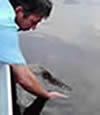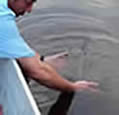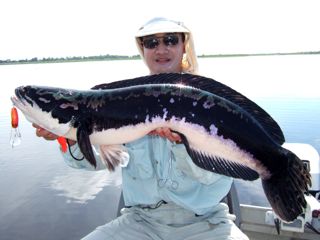
Quick-draw toman
by Christopher S.G. Tan
Till today toman are a mystery, they regularly show up, but they will not eat our offerings! If only we knew what they would eat and when they would eat at any given time, but as one lure maker said to me - "If we knew that, fishing would be boring."
A while back, I wrote an article about casting to toman when they were residing at the bankside snags instead of open water rises. The habitat I was fishing at the time was a dam, where there were plenty of woody snags. Those toman are tough to land when they get big, often cutting the line as they power back into the snag. In this article however I am going to look at another type of toman fishing.
For many years I have fished the water just south of the Klang Valley. The land there abounds with many ponds and lakes. Most of these ponds start from Puchong before ending at Sepang. A lot of the ponds there are former tin mining ponds that are abandoned or turned into sand mining areas. Unfortunately for anglers, many of the ponds around the Puchong area have disappeared into housing and industrial developments and the same goes for those ponds around Cyberjaya and Putra Jaya.
Those ponds were prime hunting ground for many anglers. For me, they were producers of haruan and toman. However, the toman there always remained elusive. They were much tougher to catch than the toman found in dams far from the cities. Blind casting would generally prove useless and so would casts to the toman fry. My friends and I spent many hours chasing these toman, but to no avail. I suppose toman close to the city are more educated compared to their brethren in the outback.
Though development shrank our huge choice of ponds, we could by chance still occasionally find a pond to pull fish out of. On one such occasion, we discovered, or rediscovered the importance of the quick draw cast when nature made these toman a bit more aggressive than normal for a "suburban" toman.
The quick draw cast is to smack the toman on the head (try to) with the lure when it rises, or just after the rise. The toman found further from the city tend to be more aggressive or co-operative to a cast after they have risen. A cast to the general vicinity of a rise may result in a hook up. At some places, one should blanket the area where a rise took place and the toman may actually take the lure several casts after the rise. At other places we discovered that blind casting can be effective around areas where toman are known to hang out.
These toman near the city on the other hand are extremely fussy. Though we knew where they hung out, which was evident from the many rises and the mass of markings on the sounder we could not get any bites. All types of offerings were presented - blind casting deep and shallow lures, jigs, soft plastics and spinnerbaits. Only one method would work: the quick draw cast; more about this later.
 We normally would work from a canoe as launching a canoe entailed less work than a boat. In addition a canoe was quieter and less tiring to paddle. In one of our many exploratory trips we came across some mysterious rises. The fish would school and rise very gracefully with wavy fins breaking the water.
We normally would work from a canoe as launching a canoe entailed less work than a boat. In addition a canoe was quieter and less tiring to paddle. In one of our many exploratory trips we came across some mysterious rises. The fish would school and rise very gracefully with wavy fins breaking the water.
I thought they could have been a school of toman, but yet they refused our regular toman lures which were about 9 to 12 cm in length. Thinking that maybe the wavy fining might be belida instead, we changed to smaller and smaller lures. However, we still had no takers. It was confounding; here was a school of fish of around a kilo each rising in front of us and yet they would not take our lures. We could only surmise that they were a non-carnivorous fish, or very smart carnivorous fish.
I remember that we started casting at these fish at around 6pm with no bites. After messing around a bit we returned after 6:30pm and out of desperation I clipped on the new Halco S125 +7m lure. I thought that maybe a nice big lure might attract its attention and the deep diver might follow the fish back down. At the first rise, I got the lure out fast and it smacked right next to the rise. Almost instantly the lure was hit. It fought friskily, and we landed it, a fat kilo plus toman.
This catch confirmed my faint suspicion that those peculiar rises were tomans! Often when angling visitors to Malaysia ask me what fish make the rises we see, I am often noncommittal, because I have found that fish often behave differently in different waters and toman are no exception. The common toman roll can be disguised in many ways, with funny swirls and rolls.
Another favourite disguise of toman is to surface without making any water movement or rings to alert predatory anglers. It just pokes the tip of its head out of the water and drops back. This is all done stealthily and unless the angler is looking at the right spot at the right time, he will not realise a toman has risen. I have also seen a school of toman feeding like sebarau. We thought they were sebarau till we cast into their splashes and had a double hook up of toman!
Where am I going? Well I just want to point out that I prefer to hook up the fish rising in those waters before deciding with finality what the fish species is that rose. Back to the fishing, shortly after that, Patrick also put in an accurate cast to a rise and hooked up a toman.
A few trips later and a few toman later we came to the onclusion: these toman are quick draw toman. Or as another friend put it; "You have to shoot from the hip!". Get the lure out fast before they go down again or else the toman will not take your lure. So basically the skills we need to have to get them to bite: speed, timing and accuracy!
Have all your senses on full alert - the hearing for a splash or swirl, the eyes peeled for the slightest sign of a rise and another sense - instinct. By instinct that something rose out of your sight, though you may not have heard anything, you turn and see the tip of the nose retreating back into the water.
Then comes the draw - your rod and reel sitting comfortably and relaxed in a ready casting position, with the lure sitting just off the tip for accurate casting. Quickly turn to face the rise, hold the rod in front of you and with a quick wrist snap to the back to load the rod, and another wrist snap forward "shoot" the lure! Hopefully this will put the lure where you want it.
This is of course in an ideal world. When fishing in a small canoe like mine, we cannot make much body movement or else the canoe may capsize. Then the lure does not always land where we want it, due to poor casting (wish we could cast like Hodgie) or windy conditions.
 Then again, accurate casts would be only the first step to catching a fish. There would be many, many accurate casts that would still be ignored. It takes hundreds, maybe thousands of casts to catch only a handful of fish. With all this practise, we were quite sure that the fish would only take the lure when it landed smack within inches of its mouth. Casts a metre away from the rise would not work, unless the fish rolled and headed in the direction of where the lure landed.
Then again, accurate casts would be only the first step to catching a fish. There would be many, many accurate casts that would still be ignored. It takes hundreds, maybe thousands of casts to catch only a handful of fish. With all this practise, we were quite sure that the fish would only take the lure when it landed smack within inches of its mouth. Casts a metre away from the rise would not work, unless the fish rolled and headed in the direction of where the lure landed.
In other words, only a lure placed near the mouth would arouse the toman's aggressive instinct to strike. That was the only way to get a bite. They would not hunt down any lures, unlike their brethren in the more isolated parts of the country. Other than that, only two fish were caught on the retrieve back to the boat, with a Halco popper and a sinking red/white Rapala Magnum, a real rarity for the locale.
Nonetheless we still caught toman with the quick draw casting, but they were not big, between 1-3 kilos. Most of the trips saw us hook up on an average of one toman each. On some trips we hooked none at all and occasionally we did better than one each. There was one good trip, when Patrick beat me thoroughly, landing 6 fish while I did not even have one bite. However I pointed out that normally those who lacked in numbers usually made up in size; that would later turn out to be a prophetic comment. That lack of big fish began to get less thrilling as these ex-mining ponds are not strewn with line snags like many dams. Then came the little bright idea of fishing with light line to make things more challenging.
to be continued....
This is what happens when we decide to fish with light lines.... A catch of a life time!
Conservation


We need to protect and conserve our resources by practising catch and release of our sportfish and protecting the habitat of our fishes.






